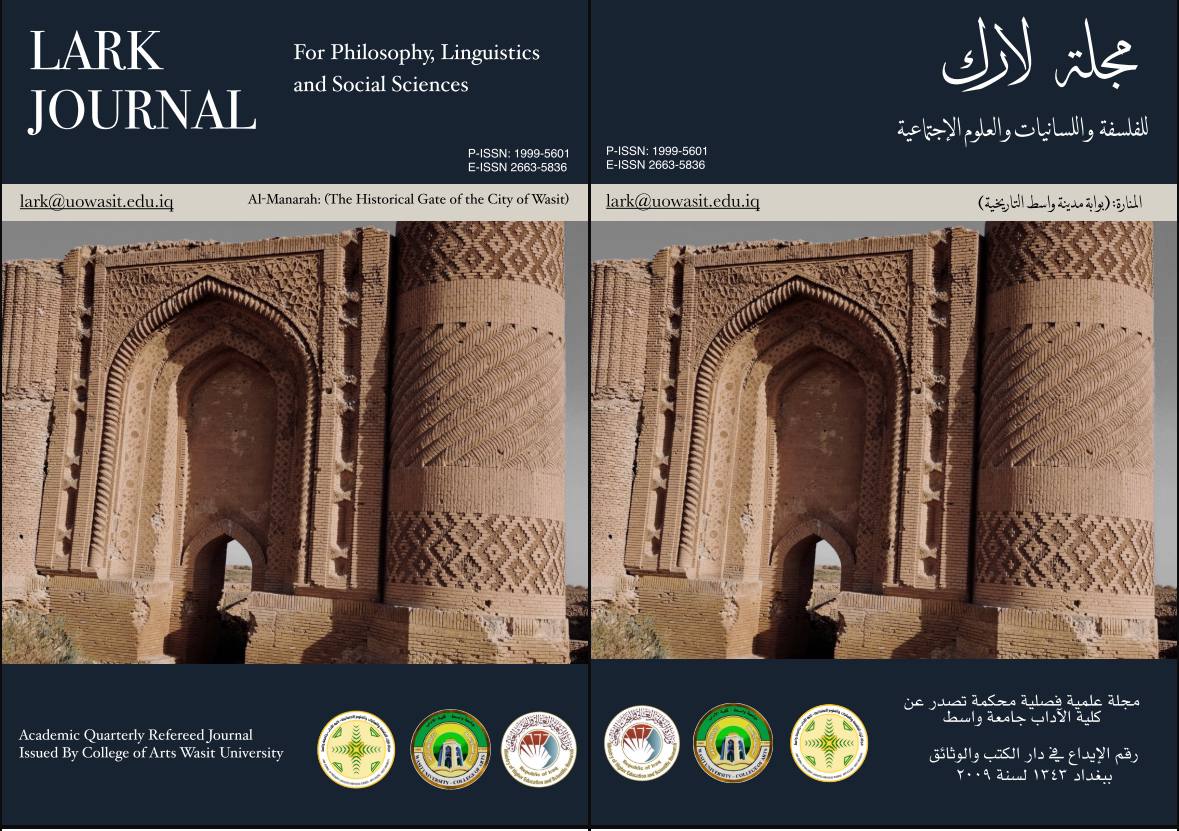Cooperative Learning in Teaching History Among Middle School Teachers
DOI:
https://doi.org/10.31185/lark.4576Keywords:
Cooperative LearningAbstract
The present study aimed to explore: (the extent to which cooperative learning is adopted in teaching history among secondary school teachers, and the significance of statistical differences in the use of cooperative learning based on the gender variable (male, female)).
To achieve the research objectives, the researcher adopted the Cooperative Learning Scale developed by Silva et al. (2024), which consists of 25 items distributed across five domains, each containing five items. The scale was constructed based on the theoretical framework of Johnson et al. (2009). The study employed a descriptive-analytical approach, and a stratified random sample of 200 history teachers (males and females) was selected from the city of Al-Kut in Wasit Governorate for the academic year 2024–2025.
The study reached the following results: (There was no statistically significant difference between the arithmetic mean and the hypothetical mean at the 0.05 significance level; and no statistically significant differences were found at the 0.05 level in the adoption of cooperative learning in teaching history among history teachers according to the gender variable (male, female)).
In light of these findings, the researcher presented a set of recommendations and suggestions.
References
• أحمد، ح. س.، ومحمود، م. ع. (2018). أثر استراتيجيات التعلم التعاوني في تنمية مهارات التفكير الناقد لدى طلاب المرحلة الثانوية: دراسة تجريبية في مصر. المجلة المصرية للعلوم التربوية، 25(2)، 112–130.
• الشطي، يعقوب يوسف واليوسف، هيفاء علي والعجمي، عمار أحمد. 2018. طبيعة اتجاهات معلمي و معلمات المرحلة المتوسطة نحو توظيف نموذج التعلم البنائي في التدريس و علاقته ببعض المتغيرات في دولة الكويت. مجلة البحث العلمي في التربية، مج. 2018، ع. 19، ج. 9، ص ص. 521-550.
• أحمد، س. (2020). فاعلية استراتيجيات التدريس الحديثة في تحسين تحصيل الطلبة في مادة التاريخ. مجلة الدراسات التربوية، 12(3)، 45-67.
• الخليفي، ن. (2021). التعلم التعاوني وأثره على تحصيل الطلبة في مادة التاريخ: دراسة تطبيقية في المدارس السعودية. مجلة البحوث التربوية، 19(4)، 101-123.
• الزهراني، أ. م. (2015). فاعلية التعلم التعاوني في تنمية التحصيل الدراسي والمهارات الاجتماعية لدى طلاب المرحلة الثانوية في السعودية. مجلة الدراسات التربوية والنفسية، 12 (3)، 45–60.
• الزهراني، م. (2019). أثر التعلم التعاوني على دافعية الطلبة نحو مادة التاريخ في المرحلة الثانوية. المجلة العربية للتربية، 27(1)، 112-134.
• العبدلي، ك. (2020). دور التعلم التعاوني في تحسين الفهم التاريخي لدى طلبة المرحلة الثانوية في العراق. مجلة العلوم التربوية، 15(2)، 78-99.
• مزهر، امير فرحان (2024): استراتيجية التعلم التعاوني للتدريسي في كلية التربية الرياضية، مقالة علمية، وقت الزيارة 12/3/2025 https://uomus.edu.iq/NewCol.aspx?newid=25877
• صالح، سجاد أيوب ، عبد الأمير، محمد جاسم (2022)، اثر إستراتيجية التعلم التعاوني بمجاميع الكترونية في تدريس مناهج وطرائق التدريس الجامعي، مجلة واسط للعلوم الانسانية، مجلد17، العدد2، DOI: https://doi.org/10.31185/.Vol17.Iss49.35
• الحسناوي، حاكم موسى عبدخضير (2019)، فاعلية أنموذج التحري الجماعي في التحصيل وتنمية التفكير التاريخي لدى طلاب الصف الثاني المتوسط في مادة التاريخ العربي الاسلامي، Journal of Education College Wasit University, 1(35), 535-588. https://doi.org/10.31185/eduj.Vol1.Iss35.845
• Gillies, R. M. (2016). Cooperative learning: Review of research and practice. Australian Journal of Teacher Education, 41(3), 39-54.
• Johnson, D. W., & Johnson, R. T. (1989). Cooperation and competition: Theory and research. Edina, MN: Interaction Book Company.
• Silva, H.S, Lopes, J, Fernandez, R, Leite.(2024): Cooperative learning scale: validation among Portuguese and Brazilian university students, Brazilian Journal of Education, v. 29, e290013, https://doi.org/10.1590/S1413-24782024290014
• Johnson, D. W., & Johnson, R. T. (2005). Learning groups and social interdependence. In W. M. Reynolds & G. E. Miller (Eds.), Handbook of psychology: Educational psychology (pp. 591–616). Hoboken, NJ: Wiley.
• Johnson, D. W., & Johnson, R. T. (2018). Cooperative learning and critical thinking in history education. Educational Review, 70(5), 543-560.
• Johnson, D. W., Johnson, R. T., & Holubec, E. J. (2009). Circles of learning: Cooperation in the classroom (8th ed.). Edina, MN: Interaction Book Company.
• Johnson, D. W., Johnson, R. T., & Holubec, E. J. (2019). The new circles of learning: Cooperation in the classroom and school. Interaction Book Compan • Smith, B. L., & MacGregor, J. T. (2020). What is collaborative learning?. National Center on Postsecondary Teaching, Learning, and Assessment.
• Slavin, R. E. (2019). Cooperative learning in history classrooms: Effects on student achievement and engagement. Journal of Educational Psychology, 111(4), 689-705.
• Saleh, Sajjad Ayoub, Abdul Amir, Muhammad Jassim (2022), The Effect of Cooperative Learning Strategy with Electronic Groups on Teaching University Curricula and Teaching Methods, Wasit Journal of Humanities, Vol. 17, No. 2, DOI: https://doi.org/10.31185/.Vol17.Iss49.35
• Al-Hasnawi, Hakim Musa Abdul Khadir (2019), The Effectiveness of the Group Investigation Model on Achievement and Development of Historical Thinking among Second-Year Intermediate Students in the Subject of Arab-Islamic History, Journal of Education College Wasit University, 1(35), 535-588. https://doi.org/10.31185/eduj.Vol1.Iss35.845
Downloads
Published
Issue
Section
License
Copyright (c) 2025 م.م. علي حسين سفيح

This work is licensed under a Creative Commons Attribution 4.0 International License.





